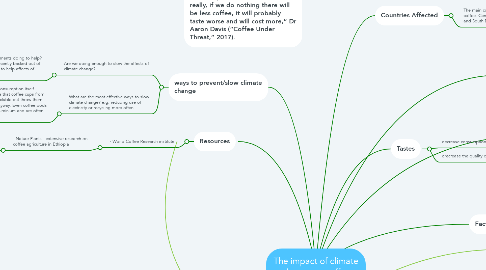The impact of climate change on coffee
by Sondoss El


1. ways to prevent/slow climate change
1.1. Are we doing enough to slow the affects of climate change?
1.1.1. What are governments doing to help? Donald Trump recently backed out of Paris Agreement to help affects of climate change.
1.2. What are the most effective ways to slow climate change? e.g. reducing use of electricity or recycling more often
1.2.1. Start with coffee consumption itself. Many are unaware that coffee cups from cafes are not recyclable but throw them in recycling bin anyway. Even coffee pods are made from aluminium and are often not recycled.
2. “In Ethiopia and all over the world really, if we do nothing there will be less coffee, it will probably taste worse and will cost more,” Dr Aaron Davis (“Coffee Under Threat,” 2017).
3. Resources
3.1. - World Coffee Research institute
3.1.1. - Nature Plants - extensive research on coffee agriculture in Ethiopia
3.1.1.1. - BBC article - outlines statistics of what could happen by 2050
4. Current solutions
4.1. Collecting genes of arabica coffee beans in "genebanks" to help coffee breeders
4.2. "An improved F1 hybrid called Centroamerica (T5296, a Sarchimor x Rume Sudan), which has yields as much as twice as high as traditional varieties, with very good quality potential." (“World Coffee Research,” n.d.)
4.3. Using technology to imrpove deforestation will improve production of coffee (“Coffee Under Threat,” 2017).
5. Facts on production
5.1. 39% - 59% of the area that coffee is farmed can be ruined by cimate change (Moat, Williams et al., 2017).
5.2. By 2050, production is estimated to decrease by 70% in South East Asia (“Coffee Under Threat,” 2017).
5.3. annual temperature of Ethiopia has increased by 1.3 °C between 1960 and 2006 (Moat, Williams et al., 2017).
6. Tastes
6.1. decrease consumption
6.2. drecrease the quality of life
7. Countries Affected
7.1. The main countries that export coffee: Central America, Brazil and South East Asia (BBC)
7.1.1. This has a global influence and can affect Australia due to the fact that coffee is mainly exported from these countries
8. Consumption has doubled in 35 years (“Coffee Under Threat,” 2017).
9. Factors influencing production
9.1. increeased temperatures decreasing land size suitable to farm
9.2. disease and insect prevelance
9.3. decreased rainfall
9.4. drought
9.4.1. Brazil Harvesters are complaining that there is nothing to collect from their farms (“Coffee Under Threat,” 2017)

